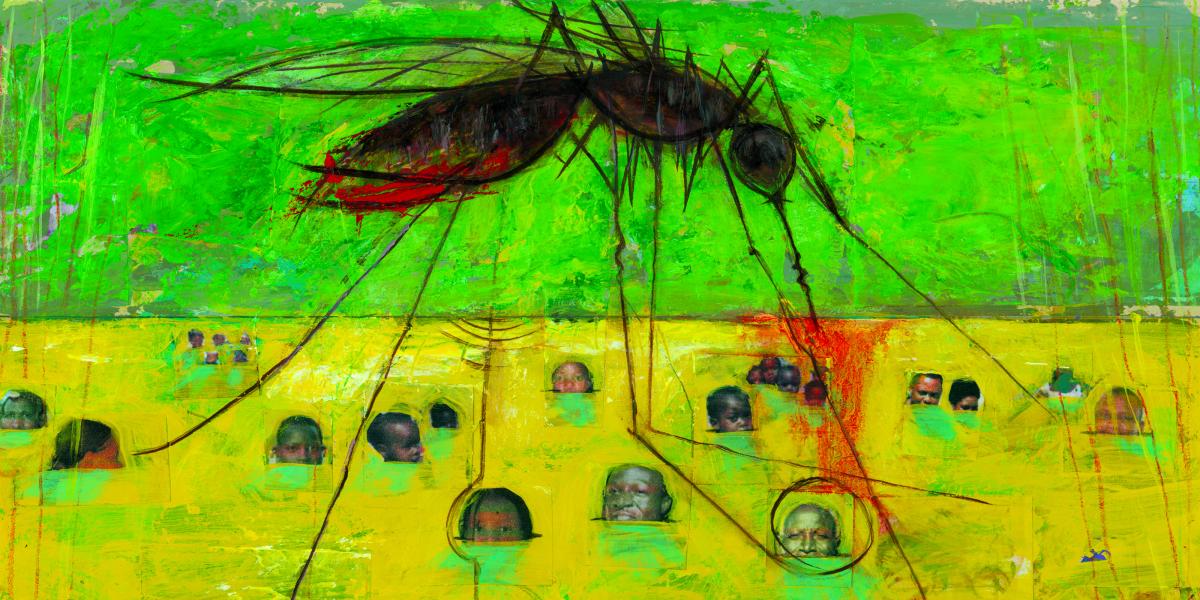End Game
After malaria transmission drops precipitously, what next?
Feverish and often near death, malaria’s most obvious victims have long been the concern of physicians and scientists.
William Moss, MD, MPH, and colleagues in Macha, Zambia, recently approached the disease from a different perspective. They focused on people infected with malaria who don’t get sick.
For every fatal case of malaria, there are perhaps 300 cases that are not. In areas of high transmission, where much of the population is repeatedly infected each year, many adults develop immunity to clinical disease. While these asymptomatic carriers do not have symptoms, their blood still harbors parasites and thus provides a hidden reservoir for sustaining the epidemic.
“The whole focus—at least in these areas where transmission has gone down—has changed to, How do we actually eliminate malaria?”—William Moss
The interest in asymptomatic carriers is a sign, in some sense, of the recent success in controlling the disease. “When this research site [in Macha] was originally established, this wasn’t on people’s minds,” recalls Moss, an associate professor of Epidemiology. When he first arrived in Macha in 2002, the parasite was the second highest cause of mortality in the country. Since then, because of the widespread distribution of insecticide-treated bednets and the highly effective artemisinin combination therapy, as well as other factors that are not well understood, the incidence of malaria in the area has fallen precipitously. In the year he arrived in Macha, Moss estimates that the hospital had more than 1,000 pediatric hospitalizations for malaria. This year, they have had four.
Moss’ research interests reflect the new conditions. Previously, the driving concern had been to reduce symptomatic disease and prevent children from dying. “The whole focus—at least in these areas where transmission has gone down—has changed to, How do we actually eliminate malaria?” says Moss.
In addition to precipitous declines in the local malaria rates, a renaissance of interest in the possibility of globally eradicating the disease that still causes more than 700,000 deaths each year has elevated this research. “Testing and treating asymptomatic individuals really only makes sense if elimination is a goal,” explains Moss, “because otherwise it’s a lot of effort and resources to target people who aren’t sick.”
In their Feb. 3 PLoS ONE article, Moss and his colleagues measured the effect on overall rates of transmission when households were proactively screened for malaria—and if necessary, offered treatment. Field teams went house-to-house using rapid diagnostic tests to identify infected individuals, whether symptomatic or asymptomatic, and offering artemisinin-combination therapy to those who tested positive. In areas with high rates of malaria, households visited by a field team every other month for one year had half the risk of infection as those visited only once. In an area of low transmission, the incidence of disease in targeted households fell even further, by more than 80 percent over two years.
While the research offers evidence that treating asymptomatic carriers can reduce population-wide transmission, there is still some uncertainty about the most efficient way to do so. The broadest approach is simply to treat the whole population with antimalarials, but this strategy is very expensive and may foster drug resistance in the pathogen. Reactive case detection, in which health care workers who diagnose cases of malaria subsequently test and treat the patient’s family and neighbors, is a more focused approach. But Moss points out that only a fraction of individuals have clinical illness and seek care in the health system, so many cases would surely be missed. The numerous home visits required might also prove onerous for local clinics, short-staffed as they already are. Moss says his vision falls somewhere in between: using a spatial risk map to test-and-treat those areas that need it most.
Even before the results of the research were published, the Zambian government began implementing test-and-treat in two southern districts, and Moss says they have treated more than 50,000 individuals there, most of whom were asymptomatic. The work conducted by Moss and his colleagues to estimate the effectiveness of test-and-treat is important because this large-scale program does not have a control group for measuring the change in malaria caused by the intervention.
For now, though, Moss believes that eliminating malaria from Zambia is “still a little bit of a pipe dream” because of its resurgence in neighboring countries, particularly Zimbabwe and the Democratic Republic of Congo. Even if the malaria parasite were eliminated from Zambia, the mosquito vector that carries it would not be. A worst case scenario would be for Zambians to lose their immunity and then for malaria to be reintroduced from outside. It would likely spread through the now-naïve population causing disease in most infected individuals. That could “really be a disaster,” says Moss.
Coordinating efforts across the region—and across the African continent as a whole—is thus of enormous importance, he says.
